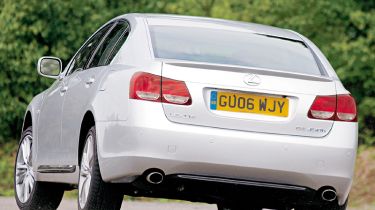Lexus GS Saloon review (2005-2011)
The GS450h is a very convincing hybrid. Eerily smooth and fast, well equipped and refined, it's the best model in the GS range.

Driving
Lexus' engineers have done a masterful job with the drivetrain. From the moment you press the Power button, the GS450h feels highly convincing. There's no noise at first, because the engine is only fired up when necessary - and since the electric motor develops a whipping 197bhp, you can accelerate surprisingly briskly without troubling the V6. What's more, it's almost impossible to detect the 3.5-litre unit cutting in. In total, the system develops 341bhp and 368Nm, and that results in a 30-70mph time of only 5.2 seconds. This is mainly down to the fact the CVT auto provides linear acceleration with no pauses or steps. But not only is it amazingly fast, it's also eerily smooth and silent, and the engine only becomes slightly raucous under maximum acceleration. What the Lexus lacks, though, is a sense of driver involvement. The slipping-clutch sensation of the gearbox, combined with the wooden brakes and vague steering, means the GS450h feels very artificial. That would be fine, provided the ride was good - but it isn't. The suspension fights on bumpy roads and isn't as fluid as it should be. The Lexus is effortlessly easy to drive and the technology is unobtrusive, but it generates little in the way of excitement.
Marketplace
It seems the British are catching the hybrid bug. Thanks mainly to the Toyota Prius, we're now beginning to embrace the new technology in the most meaningful way possible - by buying the cars. As a result, Lexus expects the GS450h to account for nearly half of GS sales here. Perhaps significantly, there's little to distinguish the newcomer. No metal changes were needed, so the only clues are the badges and unique 18-inch alloys with rather tacky chromed arms. Panel gaps are millimetre tight. Of course, the GS is currently unique - no other maker offers a hybrid executive saloon. That means, for now, competition with come from diesel-engined versions of the Audi A6, BMW 5-Series, Jaguar S-Type and Mercedes E-Class.
Owning
The GS is not the largest car in its sector; knee room is generous for those in the back, but headspace is a little restricted. But that drawback is nothing when compared to the boot. The batteries take up a lot of load areas, so the 280-litre capacity is barely half the size of its rivals. There is decent storage in the cabin though, and a huge amount of standard kit. Of course, that means there's loads of buttons - many are hidden away on a special flip-out dash pod - but despite this array of controls, we found the driving environment easy to get on with. There are drawbacks though. The red wood trim is nasty, and the high-mounted and unsupportive seat means the driving position is flawed. We also, crucially, failed to match Lexus' economy claims, as we've also seen with the Toyota Prius. The best we got was 30.8mpg at a steady cruise, which fell to 20mpg when driven hard. Only around town does it boast an advantage, where the electric motor does the work. Emissions are, however, low, and short 10,000-mile service intervals are compensated for, according to Auto Express readers, by the best (if small) dealer network in the country.







